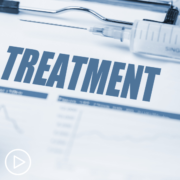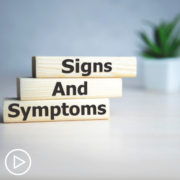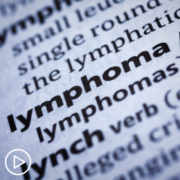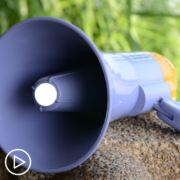Emerging Follicular Lymphoma Treatment Approaches from Patient Empowerment Network on Vimeo.
Dr. Tycel Phillips explores the latest follicular lymphoma treatment approaches. Dr. Phillips discusses CAR-T cell therapy and inhibitor treatments and provides advice on clinical trial participation.
Dr. Tycel Jovelle Phillips is a Medical Oncologist in the Hematology Clinic at The University of Michigan Rogel Cancer Center. Learn more about Dr. Phillips, here.
See More from The Pro-Active Follicular Lymphoma Patient Toolkit
Related Programs:
Transcript:
Katherine:
Okay. Are there emerging approaches for treating follicular lymphoma that patients should know about?
Dr. Phillips:
There are. So, there are some more exciting data that’s coming out, specifically looking at CAR-T, which is chimeric antigen receptor therapy. So, these are augmented T-cells that they collect from the patient, they help recognize – they help to modify those cancer cells to recognize the tumor more appropriately. And they target those tumor cells through a receptor called CD19 that’s present on the tumor.
So, that therapy has shown a significant overall response rate in follicular lymphoma. Even in very heavily pretreated patients. Right now, we’re still waiting on a longer follow up as far as the duration of the response, but as of right now it is a very encouraging therapy.
The downside to that therapy is that you can only receive it at select centers because they have to be a therapeutic approved center. So, you can’t just go sometimes to your regular oncologist’s in say, Skoboken or wherever, and get this treatment. So that’s one downside to that and also, it’s a very expensive treatment and you need insurance approval to cover that. Some of the side effects from that treatment we have gotten better at controlling, such as cytokine release syndrome, which can cause fever, low blood pressures, difficulty breathing.
That typically happens within a set period of time after the infusion of the [inaudible] [26:49] Liso-cel? Maybe chemo? The audio fully cuts out. and modified T-cells. And then there’s also what we call neurotoxicity, meaning you can have some neurological complications. Which, again, we’ve become better at managing. There are a couple CAR-T products on the market right now; all of them seem very comparable and also effective in follicular lymphoma. There’s also treatments called bispecific antibodies, these are like causally off the shelf products, except they use an antibody.
And in this antibody it has sort of two receptors. So, earlier we talked about Rituximab, which is a CD20 antibody. The bispecifics have a CD20 antibody and a CD3 antibody set. So, they bind to the tumor and also bind to your T-cells. And with the binding to the T-cells, they call it T-cell activation and expansion. And it will utilize your own T-cells to fight off the cancer. So, because these bispecifics are given as an off the shelf product, they can likely be able to be given in more accessible areas.
So, you won’t have to select centers to be given. There are still some complications with those, such as CRS and neurotoxicity, but early reports indicate that they’re much less severe and less frequency than what we see with CAR-T. But as of right now, neither the duration of responses of these treatments are still to be determined. So, again, these are two exciting sort of avenues that are moving forward for patients with follicular lymphoma that will be further developed and sort of be expanded on in the coming years.
Katherine:
I’d like to just go back for a second and ask you about inhibitor treatments.
Dr. Phillips:
Sure. So, as of right now, CAR-T with the chimeric antigen receptor therapy treatment is only approved for patients with relapsed refractory disease. The bispecific antibody therapies are only available in clinical trial. There are some other sort of cyclin inhibitors that haven’t gotten approval. So, we have the PO3 kind of Delta inhibitors, which inhibit the PO3 kind of pathway in a patient with follicular lymphoma.
There were four approved agents in this class of drugs. We had umbralisib, duvelisib, copanlisib, and idelalisib. More recently, two of those, idelalisib and duvelisib, have removed their indications for follicular lymphoma.
So, as of right now we have copanlisib which is an IDP kind of three dose inhibitor and umbralisib, which is an oral agent for the PO3 dose kind of inhibitor. So, both of those agents are typically usually targeted in the third line and beyond. So, patients who fail at least two lines of therapy. We also have tazemetostat, which is an EZH2 inhibitor, that was most recently improved. So, EZH2 mutations occur in about 20% of patients for follicular lymphoma.
But tazemetostat was actually approved for those with and without the mutation as it did show some efficacy in both. It appeared that the overall response rate was a bit higher than those who had an EZH2 mutation, with the duration of the response appears to be equivalent. But I do think for most parts in that situation, for those who lack the mutation the drug is typically used for patients who are unfit for other therapies. Whereas those who have the mutation, it typically probably will be used a bit earlier.
Katherine:
What about clinical trials? How do they fit in?
Dr. Phillips:
So, for patients with relapsed refractory disease and even some patients with untreated disease, clinical trials are sometimes your best avenue for getting some of these new and promising therapeutics before they get approval. I know sometimes patients are very cautious about clinical trials because they don’t want to be guinea pigs. But I would say all treatments that we offer you have started in clinical trials. And this is the only way to really advance the field. So, if your treating physician has a clinical trial for you, I would strongly recommend patients consider that.
Because, again, they are typically offering you something that they can’t offer you as a standard care, insurance approved treatment. And for the most part, they’re either adding drugs to what we do as far as standard of care treatment approach or offer you something that is very promising in the relapsed refractory setting or upfront setting. That compares very favorably to what we would give you as a standard of care option. That allows you to get this option sooner and earlier when you’re in better shape and less sort of beat up from the other treatments that we would give you.
Katherine:
Dr. Phillips, to close, what would you like to leave the audience with? Are you hopeful?
Dr. Phillips:
So, I think follicular lymphoma, and lymphoma in general, we are having a better understanding of the biology of the cancer, certain things that are important to the cancer, and certain avenues that we can treat the cancer and avoid some toxicities that have sort of plagued us before. So, I think moving forward there is a ton of research going into improving outcomes for patients with lymphoma, and follicular lymphoma, in general. There are a ton of other treatment options that are coming down the pipe way.
So, I think patients with follicular lymphoma should be very hopeful and encouraged that we will just continue to improve the quality of life and also the duration that they can live with this cancer. I mean, as of right now, until we can cure this cancer, our real goal is to continue to buy you more time. And time buys you more treatments. And most of the treatments that we are developing and are coming, again, down the pipeline are less toxic than some of the things we had 5, 10, definitely 15, 20 years ago.
So, your experience and your quality of life will be improved, and these treatments will also give you more longevity than you could have ever expected. So, patients with lymphoma are living a lot longer and that’s not an important thing to remember. Not hopeful, not – sorry, it’s not hopeless, even though we may say we can’t cure your cancer, the goal is as of right now is to turn this into a chronic disease such as any other chronic disease. Something that you can live with, while managing control. Hopefully, you will continue to enjoy your life and your life won’t be cut short by this cancer.




















